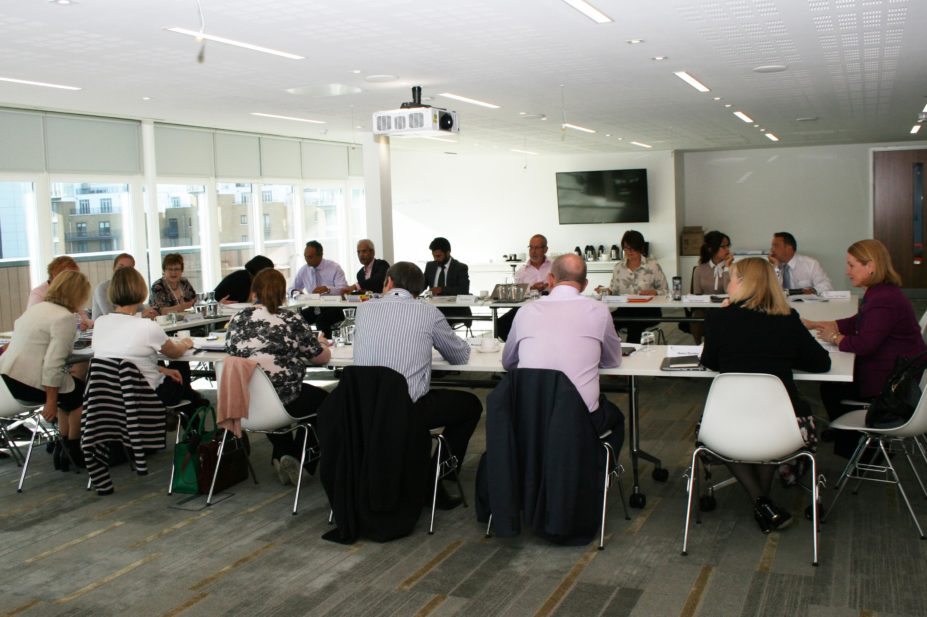
Courtesy of The Royal Pharmaceutical Society
The English Pharmacy Board (EPB) met for its first board meeting of the year on 26 January 2017, at the Royal Pharmaceutical Society (RPS)’s London headquarters in Wapping, east London.
Guests at the meeting included Keith Farrar, a former chief pharmacist, now senior responsible owner in the digital medicines domain for NHS England; Neil Watson, director of pharmacy at Newcastle Hospitals NHS Foundation Trust and programme lead for medicines optimisation; Kevin Noble, community pharmacy lead at NHS Isle of Wight; and Ravi Sharma, clinical pharmacy programme lead at NHS England.
Farrar, who is responsible for delivering the digital medicines programme for NHS England, kicked off the meeting with an update on the work of the digital medicines team. He explained that, as part of the ‘Paperless 2020’ portfolio, NHS Digital’s (formerly the Health and Social Care Information Centre) vision is to empower patients to take greater control of their own health and care; reduce the administrative burden on health and care professions; and improve the quality and availability of information.
To achieve this, NHS Digital will be following three programmes. First, it will focus on ‘digitising community pharmacy and medicines’ through the electronic prescription service and real-time exemption checking. Second, it will look at the ‘pharmacy supply chain and secondary uses’ of patient data other than for direct clinical care, such as commissioning and benchmarking. This will include implementing the recommendations of the Carter review into productivity within hospitals across England, and introducing the Falsified Medicines Directive. Finally, it will look at ‘integrating pharmacy across care settings’ through better use of the summary care record and referral to pharmacy schemes.
Meanwhile, Neal Patel, head of corporate communications at the RPS, updated the board on public affairs and policy matters. He explained that a ministerial visit to Ealing GP Federation has been arranged with David Mowat, parliamentary under secretary of state at the Department of Health, on 23 February 2017, to demonstrate to him the role of practice-based pharmacists. After this, the RPS will ask for a second face-to-face meeting with the minister to further develop the relationship. David Branford, member and immediate past chairman of the EPB, expressed concerns that there has been a misconception that money going to support practice-based pharmacists is being taken from community pharmacy. He said that it needs to be emphasised that this is not the case and that it is instead being taken from the GP budget.
Watson focused his presentation to the board on the Academic Health Science Network (AHSN) in North East and North Cumbria. AHSNs, of which there are 15 across different regions in England, were established by NHS England in 2013 to connect the NHS to local authorities and other organisations in order to help spread innovation quickly. Watson explained how the AHSN sought to change behaviours within hospital, the community and for patients and carers in order to bring a profession-wide approach to care.
Clare Howard, clinical lead for medicines optimisation at Wessex AHSN, explained how community and hospital pharmacists were working together to optimise the use of medicines but also how community pharmacists, particularly in the Isle of Wight, need leadership from within the sector in a similar way to the leadership provided to hospital pharmacists from chief pharmacists. Howard explained that the key to reducing hospital admissions is to have pharmacy at every stage of a patient’s journey.
Noble’s talk was on integration and ‘bridging the gap’. He compared systems such as Refer-to-Pharmacy, a hospital-to-community pharmacy e-referral system and PharmOutcomes, a web-based system that helps community pharmacies provide services more effectively and helps commissioners to manage the services more easily. He highlighted the demonstrable savings these systems can help achieve for trusts, clinical commissioning groups and the local health economy.
Sharma gave the EPB an update on the ‘GP forward view’, a plan committed to improving patient care and access and investing in new models of primary care. Referring to NHS England’s Sustainability and Transformation Plans (STPs), Sharma said that local leaders need to think beyond organisational boundaries to find solutions for local needs. He identified the key problems as being lack of investment, insufficient workforce and inadequate IT and said that the primary focus across England should be on investment, workforce, workload and infrastructure. He went on to say that the ‘GP forward view’ is flexible enough to allow for innovation and the ability to test out different approaches of deploying pharmacists in general practice in a way that suits local circumstances. Catherine Duggan, director of professional development and support at the RPS, suggested that Sharma work with her and the RPS director for England, Robbie Turner, to define the role of the RPS and Health Education England (HEE) to ensure that training and education is provided to pharmacists in GP practices.
Gino Martini, member of the RPS Pharmaceutical Science Expert Advisory Panel and interim country medical leader at Roche, brought up the subject of pharmacists working in industry. He said that he would like to see more preregistration students in industry placements to encourage more pharmacists to join the sector. In light of the uncertainty of Brexit, Martini expressed concerns as to whether industry in the UK will become less attractive to overseas companies. He suggested that the RPS do more to include industrial pharmacists in their campaigns and target them through the RPS Roadmap, a document that outlines career pathways for pharmacists across Great Britain, from pre-Foundation to advanced practice.
Alastair Henderson, chief executive of the Academy of Medical Royal Colleges, attended the meeting to talk about the Choosing Wisely scheme – an international initiative aimed at promoting conversations between doctors and patients to help patients choose care that is: supported by evidence; not duplicating tests/procedures already received; free from harm; truly necessary; and consistent with patients’ values. The aim is to reduce interventions that are of limited value and ensure resources are allocated to where they are most needed. Henderson emphasised that the initiative is not about making money or denying treatment but instead is about engaging with patients and directing care appropriately.
At his first EPB meeting, Robbie Turner, the RPS’s new director for England, gave a summary of the campaign, programmes and priorities for RPS England this coming year. Before his presentation he mentioned the cohesion he had recognised during his first meeting and how important this was to the organisation’s effectiveness. Included in the RPS priorities for this year are the rebalancing programme, including the decriminalisation of dispensing errors, and the reforms to community pharmacy and hospital pharmacy. In addition, the RPS will continue to support people with long-term conditions, enabled by prescribing. Deborah Evans, EPB member, asked who is currently offering prescribing courses and who is responsible for assuring the quality of courses. Ruth Wakeman, assistant director for professional development and support, said that the competency framework developed by the RPS is being used by course providers to design the curriculum and by those training to be prescribers themselves. Courses are regulated by the General Pharmaceutical Council.
Regarding the supervision of pharmacists training to be prescribers, Turner highlighted that there are differing views on the subject in some countries, such as in Wales, where the opinion is that a medic should always be involved. Duggan said that the RPS needs to be seen to welcome pharmacists as supervisors, and, where possible, call for pharmacists to work in a multidisciplinary team. The RPS also needs to develop guidance, support and mentorship for supervision. However, she also said that not every pharmacist prescriber has to be a supervisor and not every pharmacist has to be supervised by a pharmacist.
On the issue of community pharmacy reforms, being driven by government policy and funding cuts, Sandra Gidley, chair of the EPB, said that the RPS needs to be concentrating on the Murray review, commissioned by NHS England to examine the evidence base for clinical services provided through community pharmacy, published in December 2016. The RPS should focus on getting clinical services commissioned from community pharmacy in order to develop a narrative around the dangers of cutting funds further, she added. RPS members in the community sector would expect the Society to articulate concerns about further cuts, she said.
The RPS is continuing work with the Pharmaceutical Services Negotiating Committee and Pharmacy Voice on implementing the next phase of the ‘Community pharmacy forward view’ project, ‘Making it happen’.
In terms of campaigns, Turner has a three-pronged leadership plan — focusing on antimicrobial resistance, diabetes and mental health — that will develop over the coming months. Other priorities will be on putting ‘pharmacy first’ – giving members confidence that they have something to offer patients and creating opportunities for the profession. Local engagement will also be a key part of RPS work in 2017 – Turner said there needs to be a multi-pronged project rather than just the type of engagement where people meet and network and that, in future, RPS local engagement could be used to engage with STP leads about services they have taken from across the country to help inform further work.
The next EPB meeting will be held at the University of Nottingham on 5 April 2017.
You may also be interested in
Long service of members

Membership fees 2022
